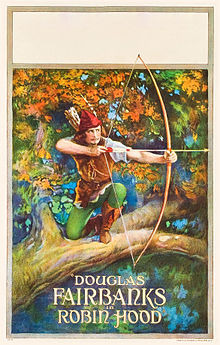Douglas Fairbanks in Robin Hood
| Robin Hood | |
|---|---|
 | |
| Directed by | Allan Dwan |
| Written by | Douglas Fairbanks |
| Produced by | Douglas Fairbanks |
| Starring | Douglas Fairbanks Enid Bennett Sam De Grasse Wallace Beery |
| Cinematography | Arthur Edeson & Charles Richardson |
| Edited by | William Nolan |
| Music by | Victor Schertzinger |
| Distributed by | United Artists |
Release dates | October 18, 1922 |
Running time | 127 min. |
| Country | |
| Languages | Silent film English intertitles |
Robin Hood (1922) was the first motion picture ever to make a Hollywood premiere, held at Grauman's Egyptian Theatre on October 18, 1922. The movie's full title, under which it was copyrighted, is Douglas Fairbanks in Robin Hood, as shown in the illustration at right.
This swashbuckler adventure was based on the legendary tale of the Medieval hero, Robin Hood and was the first production to present many of the elements of the legend that became familiar to movie audiences in later versions, although an earlier treatment had been filmed a decade before in Fort Lee, New Jersey. This movie was one of the most expensive of the 1920s: one set was an entire 12th century village of Nottingham. The story was adapted for the screen by Fairbanks (as "Elton Thomas"), Kenneth Davenport, Edward Knoblock, Allan Dwan and Lotta Woods, and was produced by Fairbanks for his own production company, Douglas Fairbanks Pictures Corporation, and distributed by United Artists, a company owned by Fairbanks, his wife Mary Pickford, Charles Chaplin and D.W. Griffith.
Primary cast
- Wallace Beery as King Richard the Lion-Hearted
- Enid Bennett as Lady Marian Fitzwalter
- Sam De Grasse as Prince John
- Paul Dickey as Sir Guy of Gisbourne
- William Lowery as The High Sheriff of Nottingham
- Willard Louis as Friar Tuck
- Alan Hale as The Squire/Little John
- Bud Geary as Will Scarlett
- Lloyd Talman as Allan-a-Dale
- Douglas Fairbanks as Earl of Huntingdon/Robin Hood (It was Fairbanks's custom to place his name last.)
Plot summary
The opening has the dashing Earl of Huntingdon (played by Fairbanks) besting his bitter enemy, Sir Guy of Gisbourne (played by Paul Dickey), in a joust. Huntingdon then joins King Richard the Lion-Hearted (played by Wallace Beery) who is going off to fight in the Crusades and has left his brother, Prince John (played by Sam De Grasse), as regent. The prince soon emerges as a cruel, treacherous tyrant. Goaded on by Sir Guy, he usurps Richard's throne. When Huntingdon receives a message from his paramour, Lady Marian Fitzwalter (played by Enid Bennett), telling him of all that has transpired, he requests permission to return to England. King Richard assumes that the Earl has turned coward and denies him permission. The Earl seeks to leave in spite of this, but is ambushed by Sir Guy and imprisoned as a deserter. Upon escaping from his confines, he returns to England, endangering his life and honor, to oppose Prince John and restore King Richard's throne. He finds himself, and his friends, outlawed, and Marian apparently dead.
Huntingdon returns to Nottingham and adopts the name of Robin Hood, acrobatic champion of the oppressed. Leading a band that steals from the rich to give to the poor, including Friar Tuck (played by Willard Louis), Little John (played by Alan Hale, Sr.), Will Scarlett (played by Bud Geary) and Allan-a-Dale (played by Lloyd Talman), he labors to set things right through swashbuckling feats and makes life miserable for Prince John and his cohort, the High Sheriff of Nottingham (played by William Lowery). After rescuing Marian from Prince John's prison and defeating Sir Guy in a final conflict, Robin is captured. The timely reappearance of King Richard returns him to Marian and foils the efforts of Prince John.
The budget for the film is estimated at approximately one million dollars. Some sets were designed by Lloyd Wright.
Wallace Beery played King Richard again the following year in a sequel called Richard the Lion-Hearted.
Alan Hale, Sr. made such an impression as Little John in this film that he reprised the role sixteen years later in The Adventures of Robin Hood (1938) opposite Errol Flynn, then played the character again in Rogues of Sherwood Forest in 1950, 28 years after his initial performance in the original Fairbanks film, which is notable for probably being the longest period for any actor to appear in the same major role in film history.
